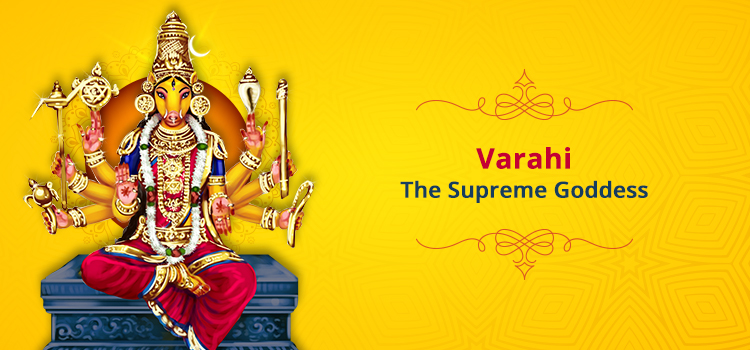One of the Saptamatrikas is Goddess Varahi (the seven female goddesses). She has a sow’s head and symbolizes the power of Varaha, Vishnu’s third avatar.
Varahi is the supreme Goddess of Hinduism’s army commander-in-chief, Devi Lalitha Tripura Sundari. Since she keeps a staff in one of her hands, she is given the name ‘Dandini.’
Varahi is the fifth Saptamatrika and is also known as ‘Panchami,’ the fifth one. Varahi is worshiped by devotees of the three major Hindu sects, Vaishnavism, Shaivism, and Sakta.

Varahi Legends
Varahi is the subject of several legends. The Goddess is the commander-in-chief of Goddess Lalitha Tripura Sundari’s Army and Mathangi, an important companion of hers. She protects the Goddess, and only those who have worshiped Varahi can receive Devi Lalitha’s wholesome blessings.
Varahi played an important role in several of Devi Lalitha’s battles with the Asuras. Several Puranas lauded her courage and strength during Devi Lalitha’s war with the three strong demons killed by Devi Lalitha, namely Shumbha-Nishumbha, Bandasura, and Rakthabeej. During the war, Varahi assassinated several commanders and relatives of the three asuras.
Varahi is also known to represent the Sakthi (power) of Varaha, a Maha Vishnu avatar. Some assume Varahi represents the power of Bhairava, Shiva’s fierce form.
Goddess Varahi’s Appearance
Varahi has a dark complexion and eight hands, each holding a weapon. She carries a variety of weapons because she is the commander-in-chief of Goddess Lalitha Tripura Sundari’s army. Varahi wields a conch, a discus, a staff, a noose, a mace, a sword, a shield, and a goad.
She rides a lion, an eagle, or a preta (corpse). According to some accounts, she has a blue complexion.
Methods of worshiping Varahi
Worshiping Varahi at night is very important. Varahi is usually invoked before sunrise and after sunset. Worship and puja can be offered to her statue or picture. Arrange the Goddess’s idol or picture on an altar and adorn it with flowers. Then, use some flowers and Kumkum (vermillion) for Archana (Pooja).
Light a lamp facing north, and also light some fragrant dhoop. As naivedyam for Goddess Varahi, boiled sweet potatoes, lemon rice, pomegranate fruit, urad dhal vada, tamarind rice, are ideal.
Chant the Varahi mantras and slokas three, twenty-one, or 108 times. You can keep track of your chant/recital with a rosary mala.
After the puja, perform the Deepa Aradhana. Varahi is believed to bestow her finest blessings upon you and assist you in realizing your sincere wishes if you pray to her for one mandala (48 days).
Benefits of Worshiping Varahi
Goddess Varahi-specific temples
Throughout the Indian subcontinent, there are numerous temples dedicated to Varahi Devi as the chief deity. Aside from that, Varahi is worshiped as part of the Sapta-Matrika in some temples. She is the main deity of the Varahi Chaurasi temple in Orissa, where tantric rites are performed.
In some temples, she is also known as Patala Bhairavi. In Chennai, there is a Varahi temple in Mylapore. A shrine to the Goddess can also be found at Thanjavur’s Brihadeeswarar temple.
Another prominent Goddess temple can be found in Coimbatore, Tamil Nadu. There is also a famous Goddess temple in Gujarat’s Gonda district.
There are several temples dedicated to the Goddess in Nepal and many other nations, including the U. S. and Malaysia. Pujas are frequently done on Amavasya as well as on Pournami days, when the Goddess is decked out in jewels and other finery.